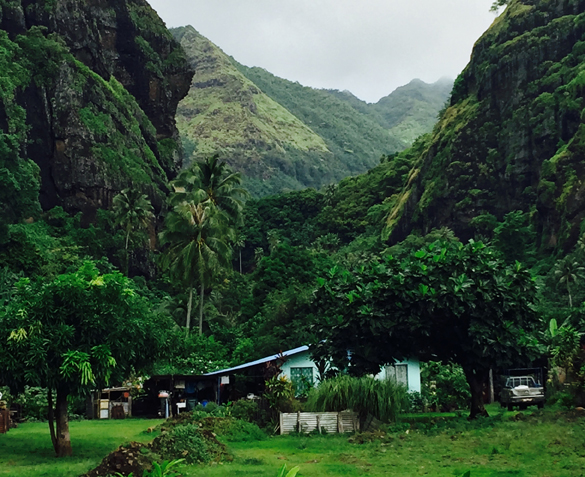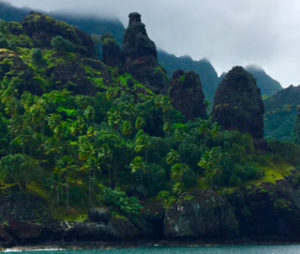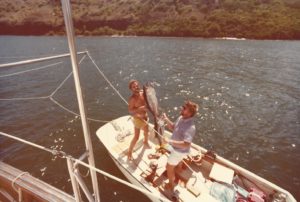
The first time I visited the Marquesas Islands was 41 years ago on board the Firebird. I was a young man ready for adventure and, after reading Herman Melville’s Typee and Thor Heyerdahl’s Fatu-Hiva: Back to Nature, I was captivated by the islands I imagined, and I was eager to visit. When we arrived at Nuku Hiva, the first of the islands we visited, I was awe-struck by the land’s beauty. I couldn’t take enough photos.
|
Blast from the Past During my time aboard the Firebird, I’d communicate with friends and employees via audio cassettes. We’d send cassettes back and forth with our updates. Here’s a 3½-minute audio excerpt from a December 1975 recording describing one of my highlights of Fatu Hiva during my first visit to the Marquesas Islands. The background noise is the wind gusting while I was recording. Click here for transcript. |
Back then, I had to mail the film back stateside for processing and then wait patiently for the final photos to arrive. Several of my favorites are in the Firebird Album 2: Marquesas Islands.
Some things change, some stay the same
I have to say, the Marquesas Islands are still one of the most beautiful places on the planet. The volcanic rock formations spiral upward into the brilliant blue sky, wild horses run freely, spectacular 1,000-foot waterfalls cascade grandly over volcanic cliffs, and the people are so warm and genuine that it takes you a little by surprise.

Since my visit in the 1970s, the island population has almost doubled, growing to about 10,000 people, yet I found the towns had changed very little, retaining much of the flavor that I remembered and enjoyed so much.
Life here continues to rely on traditional ways. The islanders still cut their copra like they did 40 years ago, sending it in bushels to Papeete, Tahiti, for processing. They grow noni and send the whole fruit to Papeete to be processed into juice and other products.
Where are the fish?
One thing that I have noticed is the drastic change in the number of fish in the water. Our fish catch has been slim pickings so far: only three wahoos with a hand line and nothing using a pole and line. That’s all, in more than a month’s time! If you threw your line in 41 years ago, you would catch a fish.

I remember taking the whaler out when the water was calm and going out more than a quarter mile to sea. We had some incredible fishing, catching large ahi tuna (up to 55 pounds), wahoo, mahi-mahi and, of course, many types of bonito.
The rough waves are also a deterrent for fishing. With no reefs surrounding the islands, the waves are high voltage and those who do fish often go far out to sea. You really don’t see many people fishing or near the water, for that matter. Rowers are the lone exception, as this sport seems to be enjoying a resurgence.
People are also weary of fish caught in certain bays because of the risk of ciguatera poisoning. This is a food-borne illness that’s not harmful to the fish, but when people eat fish contaminated with the toxin they may develop symptoms such as nausea, vomiting and neurological symptoms such as tingling sensations of the toes and hands. It is definitely not fun. What is interesting is, historically, periods of warmer waters have been linked to high levels of the ciguatoxin. That’s, unquestionably, what we are experiencing now.
Hotter than hot
In fact, everyone that we talk with on the islands is amazed regarding the high water temperatures. They are ranging from 85 to 88 degrees Fahrenheit. I don’t recall water temperatures this high 40 years ago. In fact, the ocean water is heating up globally as can be seen in the chart below. In a metal boat like the Double X, we are heating up like a Dutch Oven, even the stateroom fans are little help against the sweltering heat.
 The high water temperature could be one reason for our less-than-impressive fishing, but another reason may be overfishing. The islanders tell us that big sailing fleets from large countries come into their waters and catch a lot of their fish. (The French Polynesian government is working on protecting these waters, but that’s for another blog.)
The high water temperature could be one reason for our less-than-impressive fishing, but another reason may be overfishing. The islanders tell us that big sailing fleets from large countries come into their waters and catch a lot of their fish. (The French Polynesian government is working on protecting these waters, but that’s for another blog.)
A cultural rebirth
As the world becomes a smaller place, more and more people are beginning to learn about and visit these majestic, yet remote islands. When I visited in the late 1970s, the Aranui was a small inter-island vessel that would bring supplies a couple of times a month. A few years later, it began accommodating a handful of passengers. Today, the Aranui 5 brings hundreds of tourists to the islands with each trip. While tourism is now the main industry in the Marquesas, the islands are still remarkably unspoiled and even experiencing a cultural rebirth.
Back in 1986, members of a cultural organization had the foresight to set up the first Marquesas Arts & Cultures Festival to help counter the loss of ancestral heritage and keep Marquesas history and culture alive. That first festival took place on the island of Ua Pou and, today, it is a great event, happening once every four years on one of the three most populated islands.
The most recent festival took place last December on Hiva Oa with over 6,000 people coming from neighboring islands. It was a big deal for this little island of less than 2,000 people, and they are already planning for the next one! I’m so happy to hear this. One of my greatest joys, when I visited years ago, was the evening gatherings filled with so much fun. I recall just about everyone had a musical instrument like the banjo uke, and we would dance the night away from the tamure to the waltz to the jitterbug.
I see this revival in the arts and culture as a great touchstone to usher in a new attitude of self-reliance. Today, the island people receive financial support from the French government, but this type of subsidy system tends to create a handout mentality that can sap initiative. I believe that this renewed interest in the traditional arts and culture and similar efforts will go long way to encourage a sense of community, self-reliance and ultimately more sustainable living.
Well, Francesca is done cooking the dinner for tonight and is calling me to go for a swim. So I’ll wrap things up with a joke that Zack sent me (see below). He may be back home, but his spirit is still here. I will report back once we get to the Tuamotus.
Until next time,
![]()
|
Some of Our Sailing Humor Once upon a time there was a famous sea captain. This captain was very successful at what he did; for years he guided merchant ships all over the world. Never did stormy seas or pirates get the best of him. He was admired by his crew and fellow captains. However, there was one thing different about this captain. Every morning he went through a strange ritual. He would lock himself in his captain’s quarters and open a small safe. In the safe was an envelope with a piece of paper inside. He would stare at the paper for a minute, and then lock it back up. After, he would go about his daily duties. For years this went on, and his crew became very curious. Was it a treasure map? Was it a letter from a long lost love? Everyone speculated about the contents of the strange envelope. One day the captain died at sea. After laying the captain’s body to rest, the first mate led the entire crew into the captains’ quarters. He opened the safe, got the envelope, opened it and… the first mate turned pale and showed the paper to the others. Four words were on the paper, two on two lines: Port Left All I can say is, thank goodness we have Captain Bob. I have never seen him go through this ritual! |
P.S. Don’t forget you can subscribe to our RSS feed to have blog posts delivered right to your inbox.
P.S.S. A quick update from the Land Crew: As of this post, Dr. Sam and the Double X crew have left the Marquesas Islands and are in the Tuamotus. We have uploaded new photos in Double X Photo Album 6 and will continue to bring you all the news as it comes in.

Hi Sammy, Have been following your adventure from the beginning. Lloyd put me on the List and having been around the Polynesian Islands I can appreciate what you are seeing. Good luck and fair seas,
Ken Berry
P.S. Stanford has beaten both USC and UCLA the past two weekends. Will wonders never cease?
Congratulations on the crossing Dr. Sam! Great to hear you all made it safe and sound! Enjoy the rest of your journey.